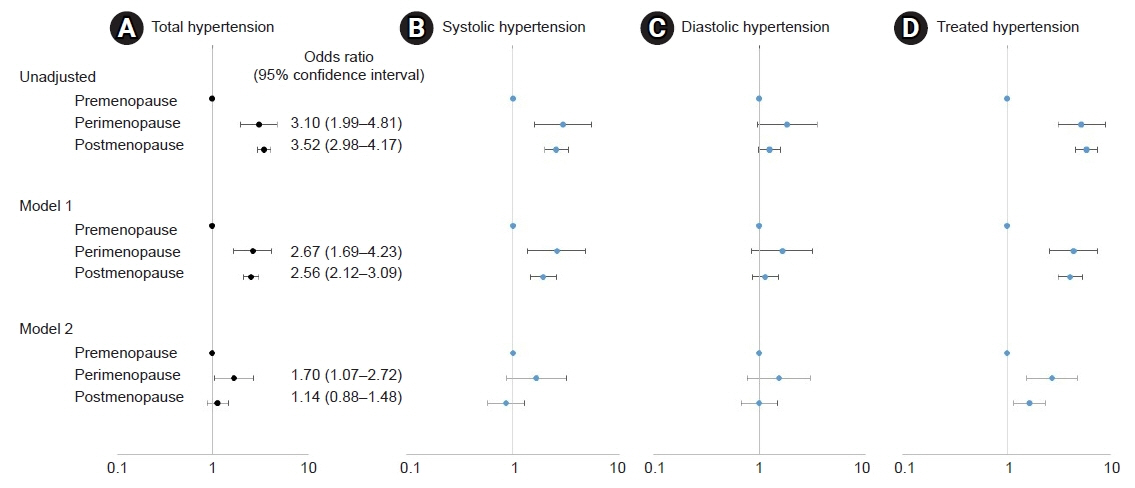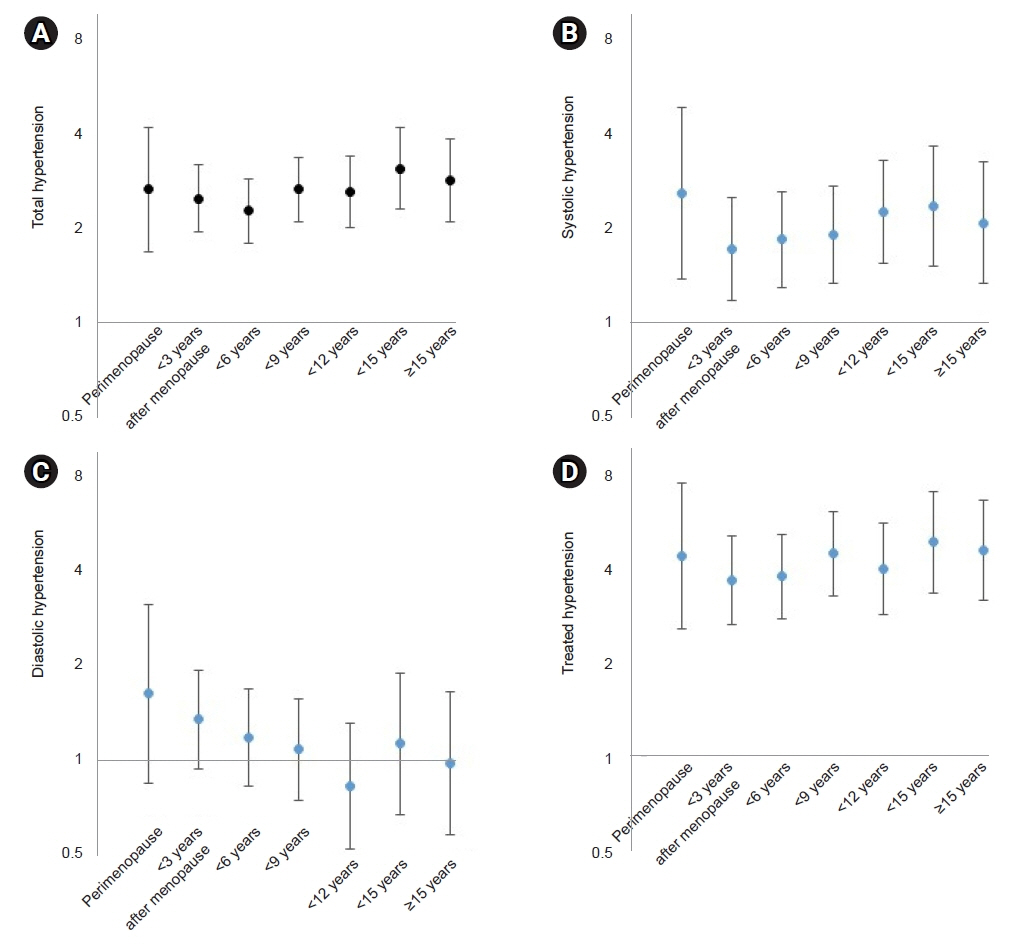Cardiovasc Prev Pharmacother.
2022 Jan;4(1):34-41. 10.36011/cpp.2022.4.e2.
Association between reproductive aging and hypertension among Korean women
- Affiliations
-
- 1Department of Preventive Medicine, Yonsei University College of Medicine, Seoul, Korea
- KMID: 2536931
- DOI: http://doi.org/10.36011/cpp.2022.4.e2
Abstract
- Background
Although postmenopausal women are well known to have a high prevalence of hypertension, it is unclear whether menopause itself increases blood pressure independently from the known risk factors of hypertension. This study sought to determine whether an association exists between reproductive aging, analyzed as a gradual transition, and an increased risk of hypertension among Korean women.
Methods
This cross-sectional study used baseline data from 5,456 women aged 30 to 64 years who participated in the Cardiovascular and Metabolic Diseases Etiology Research Center study in Korea from 2013 to 2018. The participants’ stage of reproductive aging was assessed by a questionnaire and categorized as premenopause, perimenopause, and postmenopause. Multiple logistic regression models were used to analyze the association between menopausal status and hypertension after adjusting for age, education level, marital status, employment, household income, smoking, drinking, physical activity, body mass index, and hormone replacement therapy use.
Results
The prevalence of hypertension increased with reproductive aging: 9.8% in premenopause, 25.2% in perimenopause, and 27.7% in postmenopause. The adjusted odds ratio (95% confidence interval) for having hypertension was 1.70 (1.07–2.72) for perimenopausal women and 1.14 (0.88–1.48) for postmenopausal women, compared to premenopausal women.
Conclusions
Our study shows that perimenopausal women are at high risk of developing hypertension. Since the menopausal transition may last months or years, blood pressure monitoring and early interventions are crucial for not only postmenopausal women, but also those in the transition.
Keyword
Figure
Reference
-
1. Mills KT, Stefanescu A, He J. The global epidemiology of hypertension. Nat Rev Nephrol. 2020; 16:223–37.
Article2. Global Burden of Metabolic Risk Factors for Chronic Diseases Collaboration. Cardiovascular disease, chronic kidney disease, and diabetes mortality burden of cardiometabolic risk factors from 1980 to 2010: a comparative risk assessment. Lancet Diabetes Endocrinol. 2014; 2:634–47.3. World Health Organization. Global action plan for the prevention and control of noncommunicable diseases 2013-2020. Geneva: World Health Organization;2013.4. NCD Risk Factor Collaboration (NCD-RisC). Worldwide trends in blood pressure from 1975 to 2015: a pooled analysis of 1479 population-based measurement studies with 19·1 million participants. Lancet. 2017; 389:37–55.5. Kim HC, Lee H, Lee HH, Seo E, Kim E, Han J, et al. Korea hypertension fact sheet 2021: analysis of nationwide population-based data with special focus on hypertension in women. Clin Hypertens. 2022; 28:1.
Article6. Buford TW. Hypertension and aging. Ageing Res Rev. 2016; 26:96–111.
Article7. Lima R, Wofford M, Reckelhoff JF. Hypertension in postmenopausal women. Curr Hypertens Rep. 2012; 14:254–60.
Article8. Barton M, Meyer MR. Postmenopausal hypertension: mechanisms and therapy. Hypertension. 2009; 54:11–8.9. Yanes LL, Reckelhoff JF. Postmenopausal hypertension. Am J Hypertens. 2011; 24:740–9.
Article10. Coylewright M, Reckelhoff JF, Ouyang P. Menopause and hypertension: an age-old debate. Hypertension. 2008; 51:952–9.11. Staessen J, Bulpitt CJ, Fagard R, Lijnen P, Amery A. The influence of menopause on blood pressure. J Hum Hypertens. 1989; 3:427–33.
Article12. Staessen JA, Ginocchio G, Thijs L, Fagard R. Conventional and ambulatory blood pressure and menopause in a prospective population study. J Hum Hypertens. 1997; 11:507–14.
Article13. Zanchetti A, Facchetti R, Cesana GC, Modena MG, Pirrelli A, Sega R, et al. Menopause-related blood pressure increase and its relationship to age and body mass index: the SIMONA epidemiological study. J Hypertens. 2005; 23:2269–76.
Article14. Scuteri A, Bos AJ, Brant LJ, Talbot L, Lakatta EG, Fleg JL. Hormone replacement therapy and longitudinal changes in blood pressure in postmenopausal women. Ann Intern Med. 2001; 135:229–38.
Article15. Luoto R, Sharrett AR, Schreiner P, Sorlie PD, Arnett D, Ephross S. Blood pressure and menopausal transition: the Atherosclerosis Risk in Communities study (1987-95). J Hypertens. 2000; 18:27–33.16. Oh GC, Kang KS, Park CS, Sung HK, Ha KH, Kim HC, et al. Metabolic syndrome, not menopause, is a risk factor for hypertension in peri-menopausal women. Clin Hypertens. 2018; 24:14.
Article17. van Beresteyn EC, van t Hof MA, De Waard H. Contributions of ovarian failure and aging to blood pressure in normotensive perimenopausal women: a mixed longitudinal study. Am J Epidemiol. 1989; 129:947–55.
Article18. Shim JS, Song BM, Lee JH, Lee SW, Park JH, Choi DP, et al. Cardiovascular and Metabolic Diseases Etiology Research Center (CMERC) cohort: study protocol and results of the first 3 years of enrollment. Epidemiol Health. 2017; 39:e2017016.
Article19. Shim JS, Song BM, Lee JH, Lee SW, Park JH, Choi DP, et al. Cohort profile: the cardiovascular and metabolic diseases etiology research center cohort in Korea. Yonsei Med J. 2019; 60:804–10.
Article20. Harlow SD, Gass M, Hall JE, Lobo R, Maki P, Rebar RW, et al. Executive summary of the Stages of Reproductive Aging Workshop +10: addressing the unfinished agenda of staging reproductive aging. Climacteric. 2012; 15:105–14.
Article21. Schoenaker DA, Jackson CA, Rowlands JV, Mishra GD. Socioeconomic position, lifestyle factors and age at natural menopause: a systematic review and meta-analyses of studies across six continents. Int J Epidemiol. 2014; 43:1542–62.
Article22. McEniery CM, Wilkinson IB, Avolio AP. Age, hypertension and arterial function. Clin Exp Pharmacol Physiol. 2007; 34:665–71.
Article23. Dubey RK, Oparil S, Imthurn B, Jackson EK. Sex hormones and hypertension. Cardiovasc Res. 2002; 53:688–708.
Article24. Rossi R, Chiurlia E, Nuzzo A, Cioni E, Origliani G, Modena MG. Flow-mediated vasodilation and the risk of developing hypertension in healthy postmenopausal women. J Am Coll Cardiol. 2004; 44:1636–40.
Article25. Milner TA, Contoreggi NH, Yu F, Johnson MA, Wang G, Woods C, et al. Estrogen receptor β contributes to both hypertension and hypothalamic plasticity in a mouse model of peri-menopause. J Neurosci. 2021; 41:5190–205.
Article26. Pollow DP Jr, Romero-Aleshire MJ, Sanchez JN, Konhilas JP, Brooks HL. ANG II-induced hypertension in the VCD mouse model of menopause is prevented by estrogen replacement during perimenopause. Am J Physiol Regul Integr Comp Physiol. 2015; 309:R1546–52.
Article27. Helvaci MR, Seyhanli M. What a high prevalence of white coat hypertension in society! Intern Med. 2006; 45:671–4.
Article28. Melville S, Byrd JB. Out-of-office blood pressure monitoring in 2018. JAMA. 2018; 320:1805–6.
Article29. Wing LM, Brown MA, Beilin LJ, Ryan P, Reid CM; ANBP2 Management Committee and Investigators. Second Autralian National Blood Pressure Study: ‘reverse white-coat hypertension’ in older hypertensives. J Hypertens. 2002; 20:639–44.
- Full Text Links
- Actions
-
Cited
- CITED
-
- Close
- Share
- Similar articles
-
- Do family values and reproductive health knowledge influence reproductive health-promoting behaviors in married women? A cross-sectional survey
- Development of Reproductive Health Program and Identification of Effect for Married Women Immigrants
- Mullerian inhibiting substance as a predictive marker of menopausal transition
- Predictors of Successful Aging in Korean Older Women Based on Successful Aging Theory (SAT)
- Hypertension and Vascular Aging



